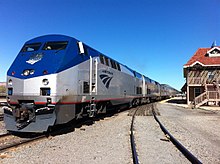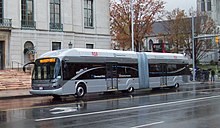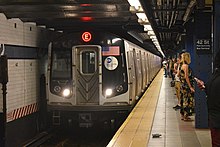This article needs additional citations for verification. (March 2022) |




The United States is serviced by a wide array of public transportation, including various forms of bus, rail, ferry, and sometimes, airline services. Most established public transit systems are located in central, urban areas where there is enough density and public demand to require public transportation.[1] In more auto-centric suburban localities, public transit is normally, but not always, less frequent and less common. Most public transit services in the United States are either national, regional/commuter, or local, depending on the type of service. Sometimes "public transportation" in the United States is an umbrella term used synonymously with "alternative transportation", meaning any form of mobility that excludes driving alone by automobile.[2] This can sometimes include carpooling,[3] vanpooling,[4] on-demand mobility (i.e. Uber, Lyft, Bird, Lime),[5] infrastructure that is oriented toward bicycles (i.e. bike lanes, sharrows, cycle tracks, and bike trails),[6] and paratransit service.[7] There is public transit service in most US cities.
- ^ Black, Alan (1995). Urban mass transportation planning. New York: McGraw-Hill. ISBN 978-0070055575. OCLC 31045097.
- ^ Haring, Joseph E.; Slobko, Thomas; Chapman, Jeffrey (January 1976). "The impact of alternative transportation systems on urban structure". Journal of Urban Economics. 3: 14–30. doi:10.1016/0094-1190(76)90055-3.
- ^ Correia, Gonçalo; Viegas, José Manuel (2011-02-01). "Carpooling and carpool clubs: Clarifying concepts and assessing value enhancement possibilities through a Stated Preference web survey in Lisbon, Portugal". Transportation Research Part A: Policy and Practice. 45 (2): 81–90. doi:10.1016/j.tra.2010.11.001. ISSN 0965-8564.
- ^ Bush, Leon R. Vanpool Implementation in Los Angeles: Commute-a-van. Aerospace Corporation, 1975.
- ^ Pavone, Marco; Morton, Daniel; Frazzoli, Emilio; Zhang, Rick; Treleaven, Kyle; Spieser, Kevin (2014), "Toward a Systematic Approach to the Design and Evaluation of Automated Mobility-on-Demand Systems: A Case Study in Singapore", Road Vehicle Automation, Lecture Notes in Mobility, Springer, Cham, pp. 229–245, doi:10.1007/978-3-319-05990-7_20, hdl:1721.1/82904, ISBN 9783319059891
- ^ Hegger, Ruud (May 14, 2007). "Public Transport and Cycling: Living Apart or Together?". Transportation Research Board. 56: 38–41 – via The National Academies of Sciences, Engineering, and Medicine.
- ^ Round, Alfred; Cervero, Robert (1996). "Future Ride: Adapting New Technologies to Paratransit in the United States". Working Paper UCTC Number 306. University of California Transportation Center.
© MMXXIII Rich X Search. We shall prevail. All rights reserved. Rich X Search
